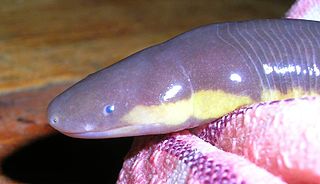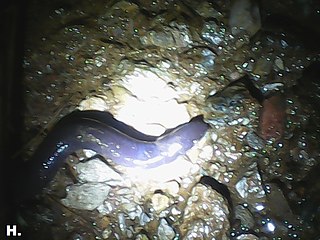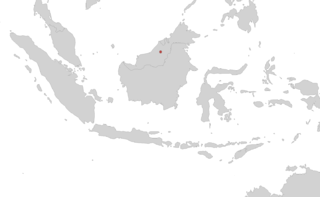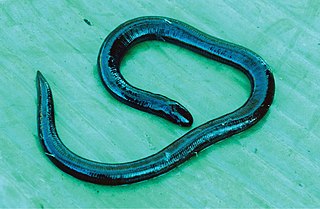
Caecilians are a group of limbless, vermiform (worm-shaped) or serpentine (snake-shaped) amphibians. They mostly live hidden in soil or in streambeds, and this cryptic lifestyle renders caecilians among the least familiar amphibians. Modern caecilians live in the tropics of South and Central America, Africa, and southern Asia. Caecilians feed on small subterranean creatures such as earthworms. The body is cylindrical and often darkly coloured, and the skull is bullet-shaped and strongly built. Caecilian heads have several unique adaptations, including fused cranial and jaw bones, a two-part system of jaw muscles, and a chemosensory tentacle in front of the eye. The skin is slimy and bears ringlike markings or grooves, which may contain tiny scales.

The Ichthyophiidae are the family of Asiatic tailed caecilians or fish caecilians found in South and Southeast Asia as well as southernmost China.

The Bombay caecilian is an amphibian found in India. This rather large species is found in the northern Western Ghats. The eyes are distinct and surrounded by a light ring. The tentacle is placed closer to the lip than the eye. A dark brown or greyish-brown species, it has no lateral stripes.

Ichthyophis sikkimensis, the Sikkimese caecilian or Darjeeling caecilian, is a species of caecilian found in India, Nepal and possibly Bhutan. It was described by Edward Harrison Taylor in 1960.

Ichthyophis orthoplicatus, also known as the Pattipola caecilian or brown caecilian, is a species of caecilian endemic to Sri Lanka. It is found in a range of natural and man-made habitats including evergreen forests, rubber and tea plantations, paddy fields, rural gardens and farms, wetlands, and cattle pastureland.

Ichthyophis pseudangularis is a species of caecilian endemic to Sri Lanka. It is found in a range of natural and man-made habitats: forests, rubber plantations, paddy fields, rural gardens and farms, wetlands, and pastureland.

The Western Ghats in India are home to several species of caecilians (Gymnophiona). Caecilians are legless, burrowing amphibians which mostly live in leaf litter, loose soil, under rocks and decaying logs. They are also found in agricultural fields and only surface during the monsoon. The body is elongated and smooth with a slimy skin. The smaller caecilians superficially resemble earthworms while the larger ones are often mistaken for snakes. However, they can be told apart from earthworms by the presence of eyes, teeth and skeleton and from snakes by the lack of scales on skin. The eyes in caecilians are not well developed which is most likely to be because of their burrowing life style. They are considered as rare which is apparently due to their subterranean habits. To see them one has to search carefully and be at the right place and at the right time. There are few places where they are common, but, at least one species was reported to be abundant in agricultural fields in Kerala. The larger caecilians can resemble snakes, but their skin is smooth, not scaly.
Sylvacaecilia is a monotypic genus of caecilian in the family Grandisoniidae. The only species is Sylvacaecilia grandisonae, also known as the Aleku caecilian or Ethiopian caecilian. It is endemic to southwestern Ethiopia and known from the Gambela, Oromia, and Southern Nations, Nationalities, and Peoples' Regions.
Ichthyophis asplenius is a species of amphibian in the family Ichthyophiidae found in Malaysia and possibly Thailand. It is also known as broad-striped caecilian, Boven Mahakkam caecilian and Malayan caecilian. It is only known with certainty from Mahakam River and Matang Hunting Reserve Its natural habitats are subtropical or tropical moist lowland forests, rivers, intermittent rivers, plantations, rural gardens, heavily degraded former forest, irrigated land, and seasonally flooded agricultural land.
Ichthyophis biangularis, the angular caecilian or Metang caecilian, is a species of amphibian in the family Ichthyophiidae endemic to Borneo (Malaysia): it is only known from its type locality, Mount Matang in Sarawak, where the holotype was collected in 1872 by Alfred Hart Everett. New specimens were collected from the type locality only in 2009. In addition, one larval sample was collected from the same region and identified as likely Ichthyophis biangularis using genetic methods.

Ichthyophis billitonensis, the Billiton Island caecilian, is a species of amphibians in the family Ichthyophiidae endemic to the Belitung island, Indonesia. Known only from the holotype, this appears to be a small species, measuring 135 mm (5.3 in) in total length. Habitat requirements are unknown but it probably inhabits moist lowland forests. It may be threatened by habitat loss caused by opencast tin mining.

Ichthyophis dulitensis is a species of caecilian in the family Ichthyophiidae. It is endemic to Borneo and only known from near its type locality, Mount Dulit in northern Sarawak, Malaysia, after which it is named. Described by Edward Harrison Taylor in 1960, the holotype was collected by Charles Hose already in 1891. It is a poorly known species with uncertain taxonomic status. Common name Mount Dulit caecilian has been coined for it.

Ichthyophis glutinosus, the Ceylon caecilian or common yellow-banded caecilian, is a species of caecilian in the family Ichthyophiidae endemic to Sri Lanka. Its natural habitats are moist tropical and subtropical forests and pastures.

The Koh Tao Island caecilian is a species of amphibian in the family Ichthyophiidae found in Cambodia, Laos, Myanmar, Thailand, and Vietnam. Also known as the Ichthyophis bannanicus, the Banna caecilian, it is also found in southern China.

Ichthyophis mindanaoensis, also known as Todaya caecilian or Mindanao Island caecilian, is a species of caecilian in the family Ichthyophiidae. It is endemic to the island of Mindanao, the Philippines.

Ichthyophis monochrous, the Western Borneo caecilian or black caecilian, is a species of amphibian in the family Ichthyophiidae. It is endemic to northern Borneo and known from western Kalimantan (Indonesia) and Sarawak (Malaysia), likely occurring also in Brunei. It is a little-known species known from only a few specimens. It presumably inhabits tropical moist forest. Adults are likely subterranean.

Ichthyophis sumatranus, also known as the Sumatra caecilian, is a species of amphibian in the family Ichthyophiidae. It is endemic to Sumatra, Indonesia. It is known from western Sumatra, but many records lack precise location data and its exact range is poorly known.
Ichthyophis nguyenorum is a species of caecilian in the family Ichthyophiidae. They were first found in Kon Plông District, Kon Tum Province, central Vietnam, in 2006, and formally described in 2012. The species is now also known from the Cat Tien National Park in Đồng Nai and Lâm Đồng provinces, southern Vietnam, and is presumed to occur more widely in suitable habitat in central and southern Vietnam as well as in eastern Cambodia.
Ichthyophis moustakius, the Manipur moustached caecilian, is a species of caecilian in the family Ichthyophiidae. It is endemic to Northeast India. This species exhibits broad lateral yellow stripes from the anterior part of its tail, along its mandibles, between its nares, as well as elsewhere. The animal can reach a length of 300 millimetres (12 in). Its head is somewhat U-shaped and fairly short; scales are absent on its collars. The species' name is derived from the Greek word moustakius, meaning "moustache", due to the yellow arched stripes it possesses.














